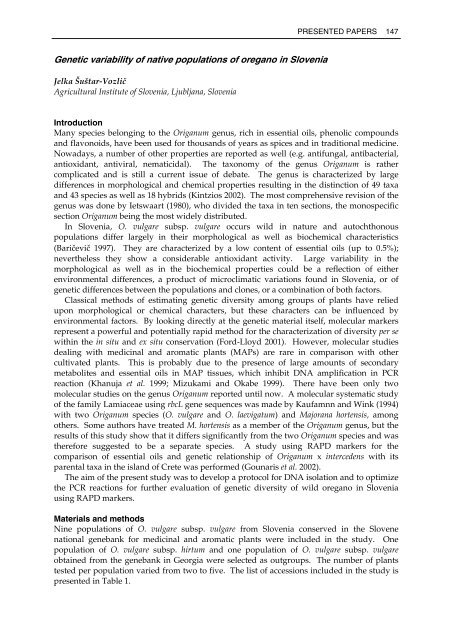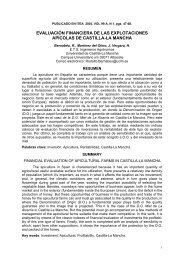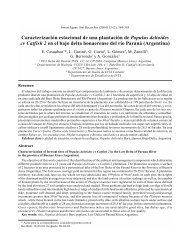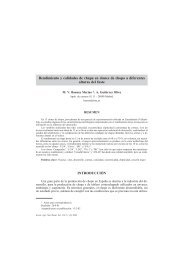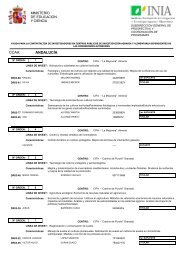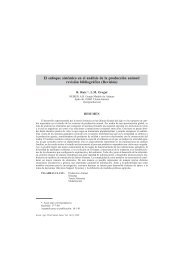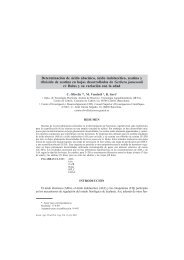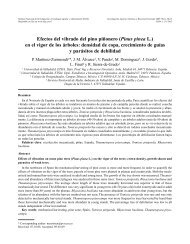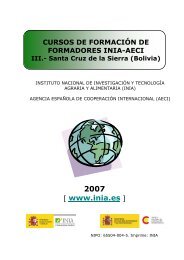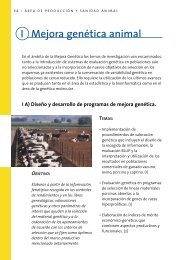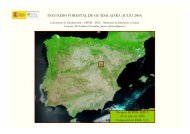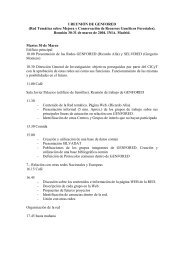Status of medicinal and aromatic plants in - Inia
Status of medicinal and aromatic plants in - Inia
Status of medicinal and aromatic plants in - Inia
Create successful ePaper yourself
Turn your PDF publications into a flip-book with our unique Google optimized e-Paper software.
PRESENTED PAPERS 147<br />
Genetic variability <strong>of</strong> native populations <strong>of</strong> oregano <strong>in</strong> Slovenia<br />
Jelka Šuštar-Vozlič<br />
Agricultural Institute <strong>of</strong> Slovenia, Ljubljana, Slovenia<br />
Introduction<br />
Many species belong<strong>in</strong>g to the Origanum genus, rich <strong>in</strong> essential oils, phenolic compounds<br />
<strong>and</strong> flavonoids, have been used for thous<strong>and</strong>s <strong>of</strong> years as spices <strong>and</strong> <strong>in</strong> traditional medic<strong>in</strong>e.<br />
Nowadays, a number <strong>of</strong> other properties are reported as well (e.g. antifungal, antibacterial,<br />
antioxidant, antiviral, nematicidal). The taxonomy <strong>of</strong> the genus Origanum is rather<br />
complicated <strong>and</strong> is still a current issue <strong>of</strong> debate. The genus is characterized by large<br />
differences <strong>in</strong> morphological <strong>and</strong> chemical properties result<strong>in</strong>g <strong>in</strong> the dist<strong>in</strong>ction <strong>of</strong> 49 taxa<br />
<strong>and</strong> 43 species as well as 18 hybrids (K<strong>in</strong>tzios 2002). The most comprehensive revision <strong>of</strong> the<br />
genus was done by Ietswaart (1980), who divided the taxa <strong>in</strong> ten sections, the monospecific<br />
section Origanum be<strong>in</strong>g the most widely distributed.<br />
In Slovenia, O. vulgare subsp. vulgare occurs wild <strong>in</strong> nature <strong>and</strong> autochthonous<br />
populations differ largely <strong>in</strong> their morphological as well as biochemical characteristics<br />
(Baričevič 1997). They are characterized by a low content <strong>of</strong> essential oils (up to 0.5%);<br />
nevertheless they show a considerable antioxidant activity. Large variability <strong>in</strong> the<br />
morphological as well as <strong>in</strong> the biochemical properties could be a reflection <strong>of</strong> either<br />
environmental differences, a product <strong>of</strong> microclimatic variations found <strong>in</strong> Slovenia, or <strong>of</strong><br />
genetic differences between the populations <strong>and</strong> clones, or a comb<strong>in</strong>ation <strong>of</strong> both factors.<br />
Classical methods <strong>of</strong> estimat<strong>in</strong>g genetic diversity among groups <strong>of</strong> <strong>plants</strong> have relied<br />
upon morphological or chemical characters, but these characters can be <strong>in</strong>fluenced by<br />
environmental factors. By look<strong>in</strong>g directly at the genetic material itself, molecular markers<br />
represent a powerful <strong>and</strong> potentially rapid method for the characterization <strong>of</strong> diversity per se<br />
with<strong>in</strong> the <strong>in</strong> situ <strong>and</strong> ex situ conservation (Ford-Lloyd 2001). However, molecular studies<br />
deal<strong>in</strong>g with <strong>medic<strong>in</strong>al</strong> <strong>and</strong> <strong>aromatic</strong> <strong>plants</strong> (MAPs) are rare <strong>in</strong> comparison with other<br />
cultivated <strong>plants</strong>. This is probably due to the presence <strong>of</strong> large amounts <strong>of</strong> secondary<br />
metabolites <strong>and</strong> essential oils <strong>in</strong> MAP tissues, which <strong>in</strong>hibit DNA amplification <strong>in</strong> PCR<br />
reaction (Khanuja et al. 1999; Mizukami <strong>and</strong> Okabe 1999). There have been only two<br />
molecular studies on the genus Origanum reported until now. A molecular systematic study<br />
<strong>of</strong> the family Lamiaceae us<strong>in</strong>g rbcL gene sequences was made by Kaufamnn <strong>and</strong> W<strong>in</strong>k (1994)<br />
with two Origanum species (O. vulgare <strong>and</strong> O. laevigatum) <strong>and</strong> Majorana hortensis, among<br />
others. Some authors have treated M. hortensis as a member <strong>of</strong> the Origanum genus, but the<br />
results <strong>of</strong> this study show that it differs significantly from the two Origanum species <strong>and</strong> was<br />
therefore suggested to be a separate species. A study us<strong>in</strong>g RAPD markers for the<br />
comparison <strong>of</strong> essential oils <strong>and</strong> genetic relationship <strong>of</strong> Origanum x <strong>in</strong>tercedens with its<br />
parental taxa <strong>in</strong> the isl<strong>and</strong> <strong>of</strong> Crete was performed (Gounaris et al. 2002).<br />
The aim <strong>of</strong> the present study was to develop a protocol for DNA isolation <strong>and</strong> to optimize<br />
the PCR reactions for further evaluation <strong>of</strong> genetic diversity <strong>of</strong> wild oregano <strong>in</strong> Slovenia<br />
us<strong>in</strong>g RAPD markers.<br />
Materials <strong>and</strong> methods<br />
N<strong>in</strong>e populations <strong>of</strong> O. vulgare subsp. vulgare from Slovenia conserved <strong>in</strong> the Slovene<br />
national genebank for <strong>medic<strong>in</strong>al</strong> <strong>and</strong> <strong>aromatic</strong> <strong>plants</strong> were <strong>in</strong>cluded <strong>in</strong> the study. One<br />
population <strong>of</strong> O. vulgare subsp. hirtum <strong>and</strong> one population <strong>of</strong> O. vulgare subsp. vulgare<br />
obta<strong>in</strong>ed from the genebank <strong>in</strong> Georgia were selected as outgroups. The number <strong>of</strong> <strong>plants</strong><br />
tested per population varied from two to five. The list <strong>of</strong> accessions <strong>in</strong>cluded <strong>in</strong> the study is<br />
presented <strong>in</strong> Table 1.


